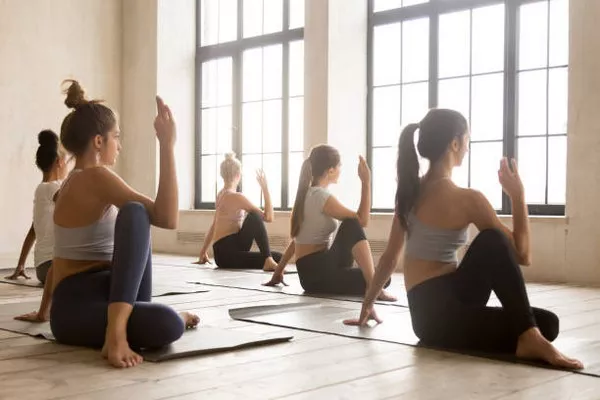Vinyasa yoga is a dynamic and flowing style of yoga that synchronizes breath with movement. It’s characterized by smooth transitions between postures, creating a dance-like sequence that can vary greatly from one class to another. If you’re wondering how many poses there are in Vinyasa yoga, the answer isn’t straightforward. Vinyasa yoga doesn’t have a fixed number of poses; instead, it incorporates a wide variety of asanas (postures) that can be arranged in countless sequences. This article will delve into the nature of Vinyasa yoga, its common poses, and how practitioners can build their sequences.
Understanding Vinyasa Yoga
What is Vinyasa Yoga?
Vinyasa yoga, also known as “flow” yoga, is a practice where postures are linked together using breath. The term “Vinyasa” can be broken down into two parts: “Nyasa,” which means “to place,” and “Vi,” which means “in a special way.” Therefore, Vinyasa translates to “placing in a special way,” which is indicative of the methodical approach to movement and breath.
Origin and Philosophy
Vinyasa yoga draws its roots from Ashtanga yoga, a more structured and rigid form of practice developed by Sri K. Pattabhi Jois. Vinyasa allows for more flexibility and creativity compared to Ashtanga, making it accessible to a broader range of practitioners. The philosophy behind Vinyasa emphasizes the fluidity of life, encouraging practitioners to embrace change and flow with the present moment.
The Flow of Vinyasa Yoga
In Vinyasa yoga, the transition between poses is as important as the poses themselves. Each movement is synchronized with an inhale or exhale, creating a seamless and continuous flow. This dynamic practice not only builds strength and flexibility but also enhances mindfulness and body awareness.
Common Poses in Vinyasa Yoga
While there’s no definitive list of Vinyasa yoga poses, certain asanas frequently appear in most classes. Here are some of the common poses you might encounter:
Sun Salutations (Surya Namaskar)
Sun Salutations are a staple in Vinyasa yoga, often used as a warm-up sequence. They involve a series of poses performed in a continuous flow, each movement synchronized with breath.
- Mountain Pose (Tadasana)
- Upward Salute (Urdhva Hastasana)
- Forward Fold (Uttanasana)
- Halfway Lift (Ardha Uttanasana)
- Plank Pose (Phalakasana)
- Chaturanga Dandasana
- Upward Facing Dog (Urdhva Mukha Svanasana)
- Downward Facing Dog (Adho Mukha Svanasana)
Standing Poses
These poses build strength, stability, and balance. They’re often included in Vinyasa sequences to create dynamic flows.
- Warrior I (Virabhadrasana I)
- Warrior II (Virabhadrasana II)
- Warrior III (Virabhadrasana III)
- Extended Side Angle Pose (Utthita Parsvakonasana)
- Triangle Pose (Trikonasana)
Balancing Poses
Balancing poses enhance focus and concentration while building core strength.
- Tree Pose (Vrksasana)
- Eagle Pose (Garudasana)
- Half Moon Pose (Ardha Chandrasana)
- Dancer’s Pose (Natarajasana)
Seated and Supine Poses
These poses often appear towards the end of a Vinyasa sequence, promoting relaxation and flexibility.
- Seated Forward Bend (Paschimottanasana)
- Bridge Pose (Setu Bandhasana)
- Supine Twist (Supta Matsyendrasana)
- Happy Baby Pose (Ananda Balasana)
Inversions and Arm Balances
Advanced practitioners often incorporate inversions and arm balances to challenge their strength and balance.
- Crow Pose (Bakasana)
- Headstand (Sirsasana)
- Handstand (Adho Mukha Vrksasana)
- Forearm Stand (Pincha Mayurasana)
Building a Vinyasa Yoga Sequence
Creating a Vinyasa yoga sequence involves more than just knowing the poses. It requires an understanding of how to link them fluidly, using breath as a guide. Here are some tips for building your sequence:
Warm-Up
Start with gentle stretches and movements to prepare your body for the practice. Sun Salutations are a great way to warm up the entire body.
Flow
Incorporate a mix of standing, balancing, and seated poses. Aim to create a balance between strength and flexibility, ensuring that each pose transitions smoothly to the next.
Cool Down
End your practice with calming poses and stretches. This helps your body relax and integrates the benefits of the practice.
Savasana
Finish with Savasana (Corpse Pose), a final relaxation pose that allows your body to rest and absorb the practice.
See Also: How Many Calories Burned In Vinyasa Flow Yoga
The Benefits of Vinyasa Yoga
Vinyasa yoga offers numerous benefits, both physical and mental. Here are some of the key advantages:
Physical Benefits
Improved Flexibility: The dynamic movements in Vinyasa yoga enhance flexibility over time.
Increased Strength: Holding and transitioning between poses builds muscle strength.
Cardiovascular Health: The continuous flow elevates heart rate, providing a cardiovascular workout.
Better Balance: Balancing poses improve stability and coordination.
Mental Benefits
Stress Relief: The focus on breath and movement helps reduce stress and anxiety.
Enhanced Focus: The mindfulness required in Vinyasa yoga sharpens concentration.
Emotional Balance: Regular practice promotes emotional stability and resilience.
Tips for Practicing Vinyasa Yoga
Whether you’re a beginner or an experienced yogi, these tips can enhance your Vinyasa yoga practice:
Listen to Your Body
Pay attention to your body’s signals. Don’t push yourself into poses that cause pain or discomfort. Modify poses as needed to suit your level of flexibility and strength.
Focus on Breath
Breath is the cornerstone of Vinyasa yoga. Ensure your movements are synchronized with your inhales and exhales. Deep, steady breathing enhances the flow and calms the mind.
Practice Regularly
Consistency is key to reaping the benefits of Vinyasa yoga. Aim to practice several times a week to build strength, flexibility, and mindfulness.
Seek Guidance
If you’re new to Vinyasa yoga, consider taking classes with a certified instructor. They can provide guidance on proper alignment, modifications, and sequencing.
Conclusion
Vinyasa yoga is a versatile and dynamic practice that offers a wide range of benefits. While there is no fixed number of poses in Vinyasa yoga, the practice incorporates a variety of asanas that can be arranged in countless sequences. By understanding the common poses and principles of Vinyasa yoga, you can create a balanced and effective practice that enhances both your physical and mental well-being. Remember to listen to your body, focus on your breath, and practice regularly to fully experience the transformative power of Vinyasa yoga.


